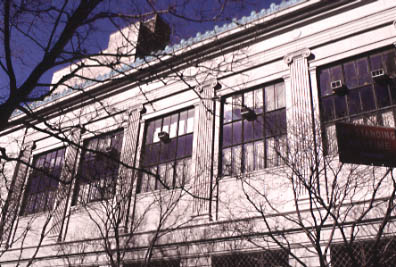 |
New York
Architecture Images-Upper West Side New York Historical Society |
|
architect |
York and Sawyer, 1908 and Walker and Gillette 1938. |
|
location |
170 Central Park West |
|
date |
1908 |
|
style |
Beaux-Arts |
|
construction |
|
|
type |
Museum |
|
|
|
|
images |
 |
|
|
|
|
notes |
As a home for the oldest museum foundation in New York (founded in 1804), this Beaux Arts edifice replaced the museum's second headquarters on East 11th Street. The Society houses an important collection of prints, books, manuscripts, paintings and decorative arts. The museum's simple but monumental facade is graced by a colonnade which recalls the temples of ancient Rome. With wings added to the northern and southern ends of the structure in 1938, this became one of the last examples of the Beaux Arts style in New York. |
|
http://www.newyorker.com/ January 11, 2005 DEPT. OF INQUIRY STUMPED NEW YORK by Rebecca Mead Issue of 2005-01-17 The New-York Historical Society celebrates its two hundredth anniversary this year, having survived, in recent decades, the threat of bankruptcy and the selling off of part of its collections. In spite of these reversals, demand has not slackened for at least one of the society’s public services: that of providing answers to arcane questions about New York City to which even the powers of Google have failed to come up with an adequate response. The questions fielded by the Historical Society’s team of three librarians, and the answers gleaned from the society’s collection of two million manuscripts, three hundred and fifty thousand books and pamphlets, and fifteen thousand maps and atlases, are the stuff of dinner-table pontification and barroom bets. In which apartment at 55 West Eighth Street did Jimi Hendrix live? (Unanswerable, unfortunately, without rental records.) How do you pronounce Coenties Slip? (The library doesn’t have a definitive answer, though it does possess a card file with a reference to a letter from 1915 in which the writer asserts, “I have recently obtained confirmation of the pronunciation ‘Quinches,’ as being the correct New York-Dutch version.”) Did Robert Moses interfere with the plans to build the Guggenheim Museum? (This one asked, presumably, by the one New Yorker who doesn’t have a copy of Robert A. Caro’s “The Power Broker” on his or her bookshelf.) The most commonly asked question is about the origin of the term “the Big Apple.” (It seems to have started with African-American stable-hands in New Orleans in the nineteen-twenties; an earlier usage of the term, in a 1909 collection of vignettes called “The Wayfarer in New York,” is, according to the Historical Society’s official line, a red herring.) The second most commonly asked question is why the name “New-York Historical Society” has a hyphen. That’s the original spelling of New York, apparently, established long before anyone thought of applying fruit metaphors to the city. The librarians are often asked to identify ancient-looking objects that were made in New York and whose purpose has become obscure. Mariam Touba, a reference librarian, was once presented with a picture of an implement comprising a narrow copper basin fitted with several small pulleys, dredged up from the galleys of the wreck of the Empress of Ireland, a steamship that sank in the St. Lawrence River in 1914. She determined that it had been an egg-boiling device equipped with an automatic timer—an implement entirely ready, you might think, for revival by Restoration Hardware. One of the more peculiar populations of visitors to the reading room, according to Nina Nazionale, the library’s interim director, are treasure-hunting divers, who are extremely cagey about the ends to which their research will be put. “They want the Hussar file,” Nazionale said, referring to a Revolutionary War-era pay ship that sank in 1780 at Hell Gate, in the East River, and has never been recovered, despite the file’s showing considerable signs of wear. The release of New York-centric movies usually prompts a spate of related inquiries. After “Gangs of New York” came out, the society’s librarians became, of necessity, instant experts in the history of Five Points. A similar barrage of questions will likely be generated by the remake of “King Kong,” which is being directed by Peter Jackson, the maestro of the “Lord of the Rings” movies. The film’s researchers have already been to the Historical Society, seeking plans of the façades of every building along the stretch of Fifth Avenue to be featured in the movie, a request that Nazionale suggested might be best fulfilled at the Municipal Archives, where copies of such photographs can be ordered for forty dollars apiece. “The researcher said, ‘Forty dollars is expensive,’” Nazionale said. Should anyone call to ask the name of the stingiest producers ever to film in New York City, now she has an answer. New-York Historical Society 170 Central Park West - across the street from the American Museum of Natural History. Current exhibit: Alexander Hamilton, wo was born Jan 11, 1757 in the West Indies. |
|
|
links |
http://www.nyhistory.org/ |